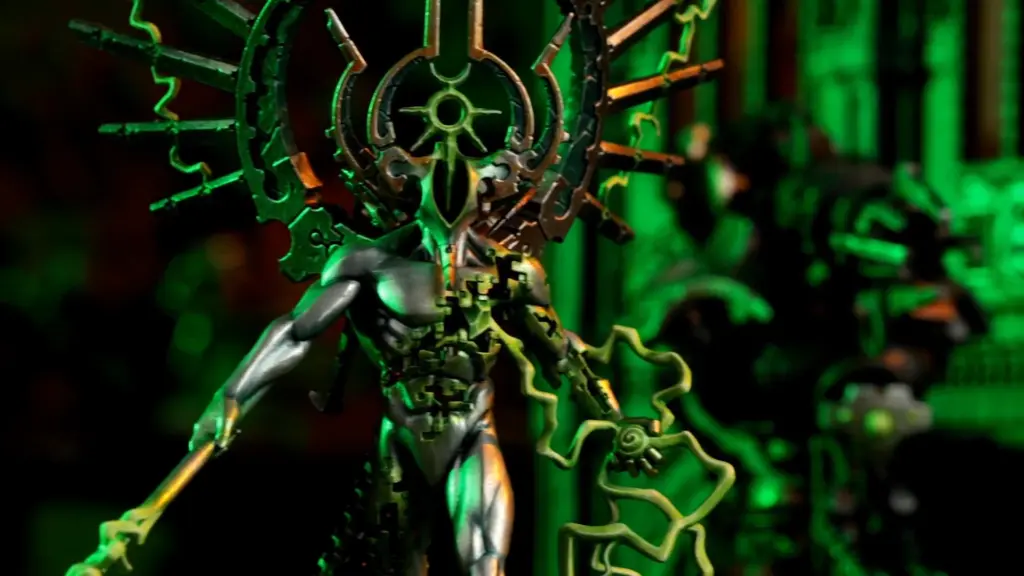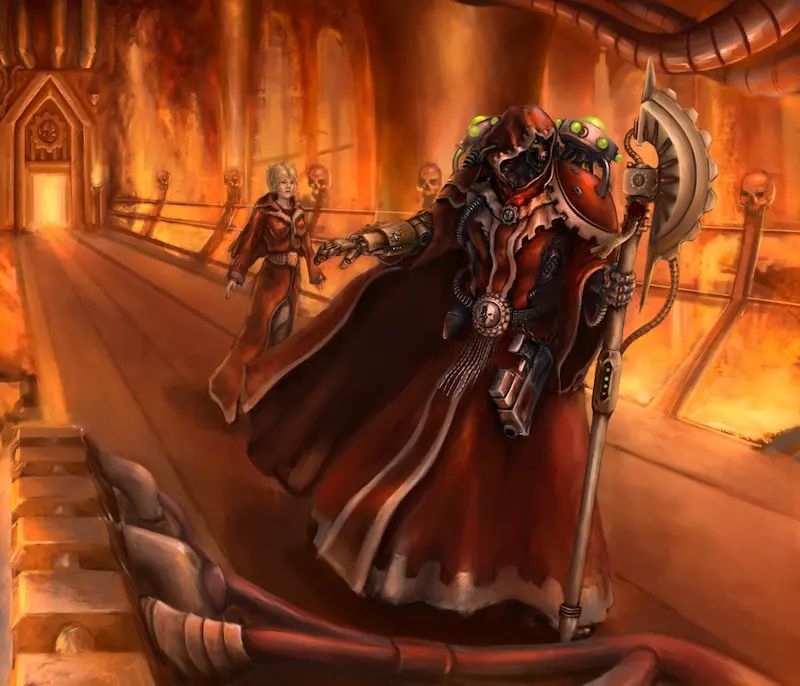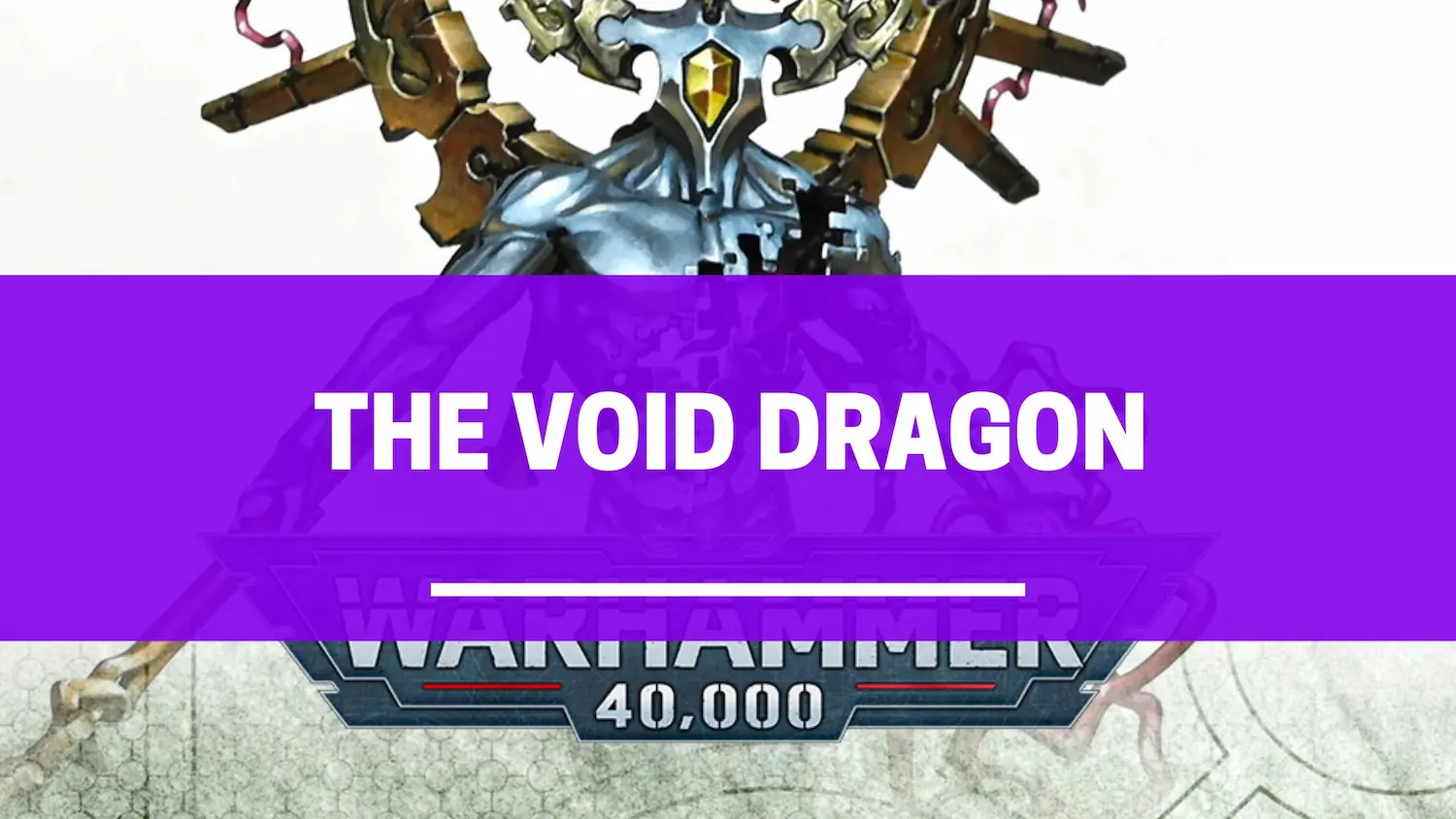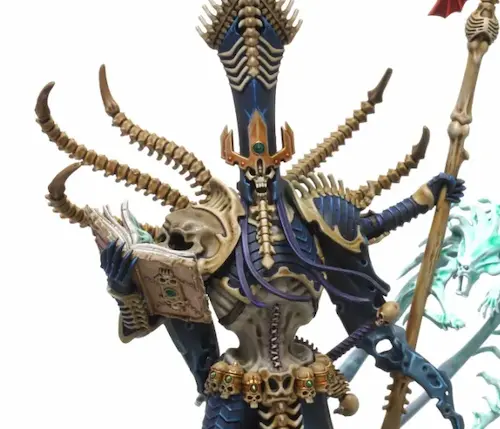In this topic I am going to talk about the Dragon of the Void, and specifically about its passage through the Horus Heresy, curiously, for not having a miniature until now, the influence of this being on the Empire of Humanity has been gigantic, more than that of any other C’tan.
Without further ado, let’s meet Mag’ladroth.
Brief reference to the ancient background
As C’tan has appeared in the Necron codex, to a greater or lesser extent depending on the edition, but always taking a secondary role in the background, in the shadow of other C’tan of greater importance (and who had mini ).
In the ancient setting, this C’tan had escaped the fate of many of his brethren following the Necron betrayal, hiding in hopes of revenge. At that time GW played a bit of cat and mouse, hinting, giving clues as to where he could be, but without expressing the place clearly and concisely (in short, the bug went on vacation to Mars).
It would make little sense for me to expand on the ancient background, since it has changed, and has changed significantly. Suffice it to emphasize that the main difference is that, in the current background, the Void Dragon is no longer a C’tan on the run, but one of those who were defeated and destroyed by the Necrons. On the other hand, what is found on Mars is not the C’tan itself, but one of its fragments.
The history of the C’tan and the Necrons.
Before we go any further, let’s recap, very briefly, the history of the Necrons and the C’tan. As surely many of you already know, I will tell it with a bit of humor and some other creative freedom, perhaps in some section it lacks a bit of accuracy, but it will be better that way.
Originally the Necrons were not Necrons, but Necontry, beings of flesh and blood. But they got tired of being alive, you know, being alive is a drag. Until one fine day they met the C’tan, primordial gods, devourers of stars, with whom they signed a pact. Thus, the C’tan took the flesh and blood ancient Necrontyr and turned them into Necrons. And not only did they change “Try” to “es”, in fact, their name change was the least of it, now they were made of metal, which was much cooler. But…

Yes, being a Necron has good things, you live forever and you save a fortune on toilet paper, but, and there was a big but, apart from the fact that many lost their minds in the transformation, those who remained sane felt empty, they missed many things good to be alive, you know, eat a good hamburger, do some rites in bed in honor of god Slaanesh (like the rite of the tiger, or the missionary, for example), pee after spending a couple of hours enduring yourself in the cinema, stuff like that (seriously there is better pleasure in the world than unloading a minute before your bladder was going to burst). For all these reasons, and a few more, but especially the last one, the Necrons got mad at the C’tan. But the C’tan were star eaters, so they wisely decided to wait before doing anything crazy.
After a long war against the ancients, the Necrons saw the opportunity they had been waiting for, and betrayed the C’tan, taking advantage of the fact that they were exhausted and weakened by the long war. But when they went to kill them, they discovered that they couldn’t, they were too powerful for it, so in an act that was the envy of Jack the Ripper himself, they broke them into thousands of pieces that they called fragments, which they locked up and enslaved.
After such hard work, it was time to rest, take a little nap for a few million years.
In the Horus Heresy, we find ourselves in this situation. The Necrons are still sleeping peacefully, waiting, and the C’tan are now their servants.
The Silver Serpent
In the Horus Heresy we find two fragments of this C’tan.
On the one hand, we have Asirnoth, the Silver Serpent. This was a creature that lived in Medusa, in the Land of Shadows, a strange place, full of ancient xenos ruins, which it is speculated could be Necron ruins.
The fact is that Asirnoth had the bad luck that precisely, Medusa, was the planet where one of the most stubborn primarchs fell, Ferrus Manus.
And he also had double bad luck, because Manus took a fancy. Legend has it that he was chasing her for days, until he grabbed her and put her into a river of magma. How could it be otherwise, Ferrus’s own arms burned, but even so the Primarch endured and endured (I already told you that he was stubborn) until he killed the snake. Ferrus was lucky, for instead of his arms being scorched, the creature’s Necrodermis clung to his skin, and from that day on, Ferrus Manus’s hands were clad in a flexible, silvery metal that lasted like ceramite itself. . (Moral, drown your enemies with your bare hands in a river of lava, you will have a prize, so that they say that warhammer 40,000 is not educational).
So, somehow, and without forgetting other factors, we can give a relevant role to this C’tan in the formation, name and character of one of the Astartes legions. After all, they wouldn’t be called Iron Hands if his primarch hadn’t met the serpent. The Meat Hands, perhaps? I don’t think so, it would be a horrible name for a legion, no, it would be another, but not the Iron Hands.
We must also add the possible influence that these remains could have on Manus and his comrades. It is possible that this fragment of the Void Dragon could influence the Primarch’s technological knowledge, just as he made the fragment found on Mars with its inhabitants. Therefore, without forgetting other important factors, in part, the C’tan influenced the ultra-technological character of the legion.
The Dragon of Mars
Mag’ladroth’s participation does not end here, and it is that we find another of his fragments in the novels and stories of the Horus Heresy, and not just any, but one that reached the very earth, during the Roman Empire.
As it turns out, the Emperor faced the shard as one of his many past identities, as a soldier under the Roman Emperor Diocletian. And not only did he face him, but he defeated him, and imprisoned him somewhere on earth, until he could take him to Mars. Such a decision was not random, but the Emperor took him to the red planet, and not to another, so that the essence of the caged C’tan would influence the minds of the Martian inhabitants, and over time, lead them to be the civilization ultra technological that it is today.
This being has since been found caged in the Noctis Labyrinthus, influencing the minds of the inhabitants of Mars over the centuries. In the novel “Mechanicum” by Graham MacNeill, we can see this influence on Dalia’s mind, in the form of a surprising mental acuity, capable of understanding and seeing all kinds of complex mechanical relationships, without her having previously learned them.
Thanks to the long time that the dragon has been on Mars, its influence has been a key, if not decisive, piece in the creation of the Mechanicum and its cult of the Machine God as we know it today.

in the image she is the young blonde behind the Adept Koriel Zeth
As a curious fact, the Dragon of Mars is guarded by a guardian, who is in charge of watching over it and preventing it from escaping. For such a task, the Emperor gave a part of his power to the Original Guardian. As this caste all and being wise and psychic of great power, they cannot live forever, they pass on the power of the Emperor to the next, so that he can carry out such a task.
Conclusion
In summary, the intervention of the Necrons, and more specifically of this C’tan, during the great crusade and the heresy is subtle, but relevant, very relevant. In fact, from what we can read in “Mechanicum” his relationship with the Cult of the Machine is very close and decisive, to the point that we can affirm that said faction owes a lot to this C’tan.
The influence on the Iron Hands is more anecdotal, but no less interesting.
Undoubtedly a peculiar and very interesting C’tan. I can’t wait to know what they will say about him in the new Codex Necron.




